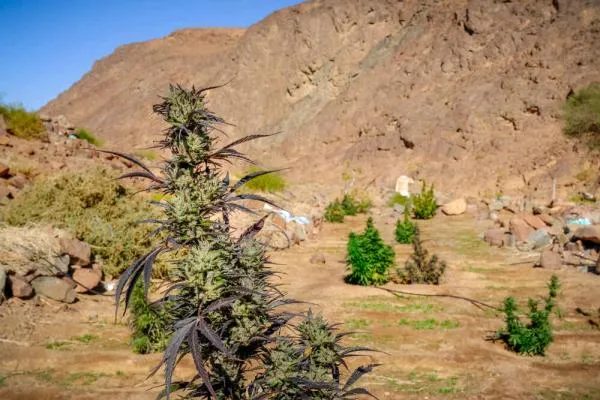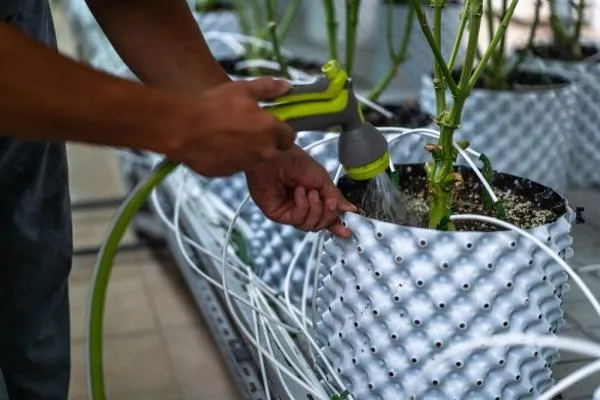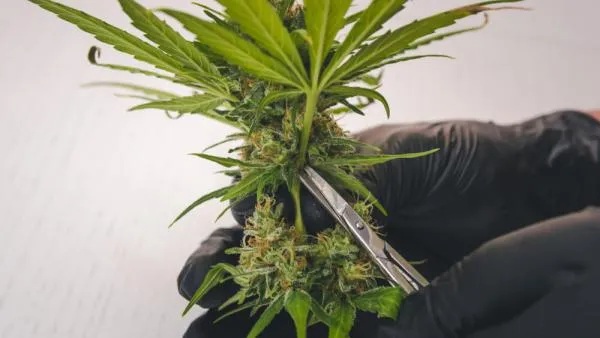So you've poured your heart and soul into your first cannabis crop, and today is the day to cut those bad girls down. What's next? This article will cover everything you need to know about drying weed.
Ask any experienced grower, and they're going to tell you that growing the crop is really only half the battle.
The process after you harvest is just as important. While it's pretty straightforward, you do need to follow some important steps and keep an eye on certain environmental factors to make sure you end up with the best possible product.
Let's dive straight into the best ways for drying your cannabis crop!
- Why is it important to dry weed?
- Should you trim fan leaves before drying?
- What is the difference between drying and curing weed?
- Hanging the whole plant to dry vs. drying individual branches
- Hanging the whole plant to dry – A step-by-step guide
- Step-by-step on how to dry buds without hanging the entire plant
- The Perfect Drying Environment for Cannabis
- How to dry weed quickly?
- The Wrap Up
Why is it important to dry weed?
There are a few reasons why drying marijuana in the correct way, is critical to the final quality of your buds.
Terpene Production
For starters, drying weed slowly and at the right temperature will help to preserve those all-important terpenes. Terpenes are the building blocks of essential oils, and are found throughout the plant world. They are responsible for giving cannabis strains their unique flavor and smell, but they also have their own set of therapeutic properties.
Thanks to the recent shift away from cannabis prohibition, the opportunity for proper, in-depth, peer-reviewed research into everyone's favorite plant is finally becoming a reality. A significant number of these studies have been focused on isolating the individual terpenes found in weed, with findings showing that the cerebral and medicinal effects are controlled not only by the cannabinoid content (CBD, THC, CBN, etc) but also by the specific terpenes. Certain studies have also shown that terpenes could be used to modulate the effects of THC, making it more or less psychoactive, depending on the specific terpene.
The Quality of the Smoke
One of the major factors in the harshness of a joint, bowl, or vape hit is the amount of chlorophyll present in the bud being smoked.
Chlorophyll slowly degrades during the drying (and curing) process and is one of the main reasons why we look to dry harvested marijuana within a specific timeframe.
Will all the chlorophyll disappear during the drying period?
Well, no. But if you dry your weed in the correct environment for the right amount of time, you'll go a long way towards a delicious and smooth smoking experience.
Cannabinoid Potency
Cannabinoids are the active compounds in cannabis that give the plant it’s various effects. THC is responsible for the psychoactive "high", while CBD flower is known for its medicinal benefits - although the more we learn about weed, the more it seems that all of these compounds work 'hand-in-hand' to offer the benefits we enjoy.
Both of these, as well as all the other cannabinoids present in marijuana, will degrade if not dried and stored properly. In particular, THC is very susceptible to degradation when exposed to light, heat, or oxygen.
Drying weed is all about slowing down these degradation processes so that you can enjoy your stash for as long as possible!
Mold and Pest Prevention
It goes without saying that pests and mold are the number one enemy for cannabis growers. But the battle isn't over when you cut your crop down.
If you live in an area with a high humidity level, then drying your weed is critical to preventing mold or pests from wrecking your entire crop. These nasties can develop very quickly in humid conditions, and often go undetected until it's too late. I'll discuss this further in the next section.
Should you trim fan leaves before drying?
Yes, or no. It really depends on your dry room, and the ambient environment.
Further down in this post we will run through the exact temps and humidity you should be looking to keep your dry room at, but in terms of trimming fan leaves, it's pretty simple.
If you live in a hot, humid area then you may struggle to keep the humidity and temps at the correct level. In this case, yes, you should definitely consider removing as much of the plant material as possible. This includes cutting off the fan leaves, breaking the plants down to the branches, and possibly even wet trimming before you hang it all up to dry.

On the other hand, if you live in a temperate area with low humidity, then you shouldn't have any problems drying your weed without trimming the fan leaves. In fact, some growers believe that drying with the fan leaves still intact helps to preserve more of the terpene profile.
Before you make any decision, set your dry room up, see if you can control the environment to your liking, and go from there.
What is the difference between drying and curing weed?
Drying is the initial 7 to 12 day period where you hang the whole plant, or branches, in a controlled environment to slowly remove most (but not all) of the moisture from the plant as possible.
Curing is the next stage of the process. After you have dried your buds, it's time to place them into airtight containers (most growers use glass mason jars). Everyone knows that a whiskey that has been aged for 10 years is usually going to be superior to one that has only sat in a barrel for 3 years, right?
Well, think of curing in the same vein. Luckily, it doesn't take nearly as long. Most strains will need a 2 to 4 week curing period although many experienced cultivators will let them cure for up to six months. It's during this time that the terpene profile matures, allowing for those amazing flavors to really pop.
Curing is a process in itself and our professional curing guide illustrates this in detail.
[block class="FishPigExtend\Wordpress\Block\Post\Widget\Related" ids="450"]
Hanging the whole plant to dry vs. drying individual branches
You may have seen some growers drying their weed by hanging the whole plant upside down, whereas others will carefully cut the plant down into individual branches and hang them to dry that way. So, which is the best method?
The answer is that it comes down to environmental factors. Obviously, a whole plant will take longer to dry than individual branches, so if you are in full control of the dry room environment you can go with either option.
Personally, I prefer to dry plants as a whole, but I don't usually grow 5-pound monsters. Size is definitely something to consider, as drying a huge plant whole isn't always that feasible.
Pros and Cons of Drying Whole Plants
Pros:
- The drying process is slowed
- It can be easier to control (although the opposite may also be true, it really depends on your situation and the size of your plants.)
- Less work (no need to cut the plant up)
- Some cultivators swear by the fact that the terpene profile will be 'richer', although there are no studies to back this claim up. I personally do find that plants that have been dried whole do taste better in the long run, but that may be confirmation bias on my part
Cons:
- You may need a larger dry room
- The chances of mold developing are increased, especially if you lose control of the ambient humidity levels. This can happen very quickly in an overly humid environment
- It just may not be possible, depending on the size of the plants
Hanging the whole plant to dry – A step-by-step guide
Hanging a whole plant for drying is very straightforward, but needs to be done carefully.
- Cut the main stem of the plant near the base, below the lowest branch. Do this slowly and carefully. Remember that each time you touch or move a plant, at least a few of those precious trichomes will fall.
- Hang the plant UPSIDE DOWN, and suspended by the main stem. There are a few ways to go about this, but I like to run lines of wire along the length of my dry room and then tie the plants to this.

- Regular twine works great for tying up the plants, but be sure to loop this not only around the main stem but also some of the lower branches to make sure the plant doesn't slip out and fall. We hang the plants upside down to help with even drying throughout the whole plant.
- Do not, I repeat, DO NOT constantly check the dryness by squeezing the buds themselves. This is a common mistake for beginner growers and can cause the flowers to oxidise (as can wet trimming) which leads to harsh smoke. Instead, feel the smaller branches to get an idea of where the plant is at. Once they feel ready to snap relatively easily, it's time to carefully check the flowers.
- Once the flowers are feeling nice and crispy, and the small stems that connect them to the branches are easily snapped by hand then it's time to start removing them. If you are dry trimming then this is the time to get going.
Step-by-step on how to dry buds without hanging the entire plant
- Once you are sure that the plant is ready to be cut down (head over here to read our guide on when to harvest your cannabis plants), start by removing the branches from the main stem.
- The best way to do this is to go top to bottom, chopping the main stem just below each branch. This creates a natural hook to hang the branches. There are a bunch of different ways to hang your branches.

- On the larger farms that I have worked on, you usually find that the dry room (or rooms) is filled with walls of fencing or chicken wire, which offers a huge amount of hanging space from floor to ceiling. If you are running a smaller grow, you can run some rope, twine, or wire through your grow tent (tents make great dry rooms as they offer easy environmental control) and hang the branches directly from there.
- Another option is to make your own DIY dry area from a large cardboard box. These offer less environmental control, and the cardboard itself can pull moisture from the plants quite quickly, so while they are handy and easy to make, they can speed up the drying process which isn't an ideal way to combat this is to cover the inner walls of the box with aluminum foil, or even better mylar sheets which can be easily sourced from most hardware stores.
- From there, the process is the same as for drying a whole plant.
The Perfect Drying Environment for Cannabis
The drying environment is critical for preserving your weed's terpene profile, cannabinoid potency, and preventing mold.
What is the ideal temperature for drying cannabis
The ideal temperature for drying cannabis is between 70-75°F (21 to 24°C).
Keep in mind that it's always better to have your dry room a little cooler and less humid than overly warm and sticky, as this will help ensure that no mold issues pop up. Trust me, there are very few things in this life more devastating than growing a great crop only to find mold has found a way in during the drying stage, wrecking all that hard work.
What is the ideal humidity for drying cannabis
The ideal humidity level for drying weed is between 50-55%. After the first 4 or so days of the drying process, you can drop the humidity levels to 45-50% to see the best results. If the humidity level gets too low (below 30%), the drying process will speed up dramatically but not in a good way (more on this further down). If it gets too high (above 60%), you are at a much greater risk of developing mold or bud rot.
You also want to make sure that there is good airflow in your drying area. This helps with evaporation and prevents mold by keeping the air moving. That doesn't mean you should have an AC or fans blowing directly at the buds - don't do this, it will lower the quality of both the terpene profile and the cannabinoid potency. What is most important is that you ensure there is sufficient air exchange in and out of the drying area.
How long does it take to properly dry weed?
In a perfect world, the drying process should take between 7-12 days, but this will vary depending on the size and density of your buds, as well as the temperature and humidity in your drying environment.
How dark does a drying room need to be?
Dark. Pitch black if possible, or as close to. Sunlight and UV is a cannabinoid killer once the plants are cut down, so try to keep the dry room nice and dark.
How do you know when your buds are fully dry?
They should be crispy to the touch and easily snap off the branches. Keep in mind, we do want the bud to be ever so slightly moist internally to help with the curing process, but when I say ever so slightly that's exactly what I mean. You shouldn't be able to really tell that they still have a small amount of moisture still trapped inside the buds.
How to dry weed quickly?
A question I hear asked all the time is "is it possible to quickly dry weed?". The answer is yes, of course. But when you quick-dry marijuana you will 100% lose some of the potency, and the terpene profile will never have a chance to shine.
There is also nowhere near enough time for chlorophyll degradation, so the smoke will not only be less potent and tasty, it will also be way harsher.
But, we've all been there. especially with your first few harvests, the temptation to bust a few buds into the oven and dry them off quick smart is hard to deny. But, hold up! There are better ways to go about it, without having to roast them.
My preferred method (if you can call it that - I never quickly dry flowers these days and haven't for a very long time) is to throw a few of the popcorn buds into brown paper bags and hit them with a fan. To speed things up even further, you can grab a hairdryer and hit the bags with this, but be careful not to heat them up too much.
Should you quickly dry your precious weed? No, but you probably will anyway.
And if you are in a rush and decide to try out the brown paper bag and hair dryer method, remember to only use the worst buds from the crop. The lower branches produce much smaller, less dense, and less potent flowers.
Maybe you have another ingenious way of quick drying the Mary Jane? If so, let us know in the comments below!
What's next?
Now that your weed is thoroughly dried, the final step towards producing top shelf bud is to cure your cannabis. This involves sealing the your bud in an airtight container and burping them at regular intervals which matures the bud and helps to preserve its taste, smell and potency. A proper cure requires patience as it takes 3-6 weeks, however the wait will be more than worth it.
The Wrap Up
So, there you have it. Everything you need to know about drying weed. Now get out there and dry your buds like a pro! Just remember - patience is a virtue, especially when drying and curing cannabis.
If you are interested in learning a bunch more about growing your own, check out our cannabis cultivation guide. We cover everything from germination to harvest, so you'll be an everyday Dr. Green Thumb in no time.











1 Comment